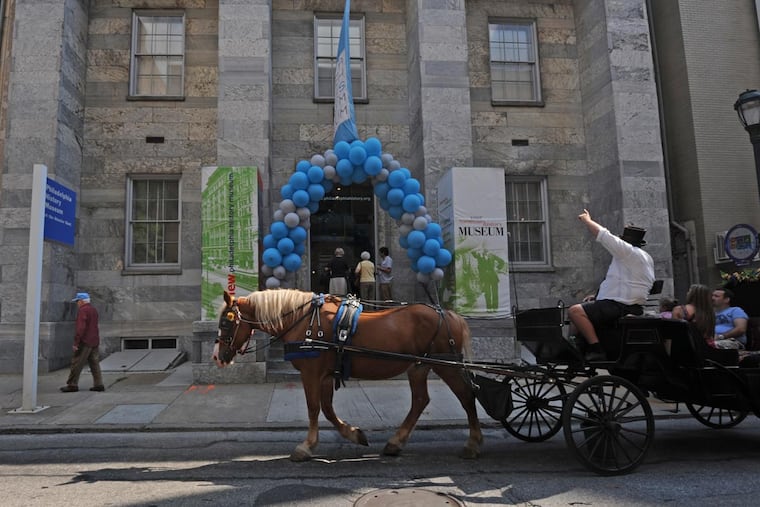Woodmere, Philadelphia History Museum mull a merger
The Philadelphia History Museum at the Atwater Kent and the Woodmere Art Museum are exploring a partnership that could produce a merged institution devoted to exhibiting more than three centuries' worth of the region's entire range of art and artifacts, according to officials at both institutions.

The Philadelphia History Museum at the Atwater Kent and the Woodmere Art Museum are exploring a partnership that could produce a merged institution devoted to exhibiting more than three centuries' worth of the region's entire range of art and artifacts, according to officials at both institutions.
The exploration process, funded by William Penn Foundation grants of $867,075 to each institution, will initially lead to a joint public exhibition opening in about a year at both, tentatively titled "A More Perfect Union."
Officials are weighing how their collections interact, how staffs and boards operate together, what new visitors will see their collections, and what might attract new donors and board members to a venture of such scope.
The Philadelphia History Museum, mandated by the City Charter as the official repository of Philadelphia's material culture, is housed in a neoclassical building on South Seventh Street. The original home of the Franklin Institute, it was donated by radio manufacturer Atwater Kent to create a public history repository. The collection is owned by a private nonprofit for the public benefit.
Woodmere, in Chestnut Hill on the estate of the museum's founder - oil man, politician, and collector Charles Knox Smith - has a collection of about 5,000 works, with particular strength in the region's 19th- and 20th-century art. Smith left the estate and collection to the public; it has been owned and operated as a private nonprofit since 1940.
The History Museum, which contains art and artifacts from its own collection as well as those it acquired in a 1999 agreement with the Historical Society of Pennsylvania, has more than 100,000 items, including the formidable desk used by George Washington during his presidency, and artworks by Thomas Sully, the Peale family, and many others.
"We both have collections of Philadelphia-centric stories," said Charles Croce, director and chief executive of the History Museum. Woodmere's "is more contemporary than ours. Ours is more object-based; theirs is two-dimensional-art-based. The idea is to put these two collections together to tell the story of Philadelphia."
The exploration process is expected to run at least a year and a half.
"We're asking a lot of questions right now," said William Valerio, Woodmere's director and chief executive. "We're setting up the ["More Perfect Union"] exhibition in a way that will give some answers and some sense of what is it in the past of Philadelphia that's relevant . . . today. That's ultimately the goal, to employ our collections toward this question of how does the past matter to the present.
"Our sense, Charles and myself, our staffs, our boards - we have a sense that by bringing art and history together we can explore culture in a broader sense and in a way that isn't being done currently with any collection in Philadelphia."
Croce and Valerio said each institution would remain where it is. Neither believes institutional charters and conditions of bequest will present legal obstacles to a partnership - or even a merger, if that ultimately happens.
News of a possible merger comes at a time when there have been high-profile unions in the city - the Academy of Natural Sciences merged with Drexel University, and the Rosenbach Museum and Library with the Free Library of Philadelphia.
The History Museum-Woodmere partnership is somewhat different. Neither is a behemoth, and both have had financial and operational struggles in the near past.
Woodmere abandoned an ambitious expansion plan several years ago and operated for a time without a director or other key staff positions filled. Since Valerio arrived in September 2010, the museum has put together a string of balanced budgets, built up its endowment, and this year raised $1.5 million for replacing drives, lighting, and other amenities. Its annual operating budget this year is up to $2.4 million, and endowments stand at $10.6 million. Annual attendance is about 40,000.
The Philadelphia History Museum completed a lengthy $6 million building overhaul three years ago and has paid down a $2.5 million construction debt to $250,000. Its staff is lean, and fund-raising is an ongoing issue. The city provided a $293,000 subsidy this fiscal year; total annual operating budget is $1.6 million, with the endowment at about $1 million. Attendance hovers around 25,000 annually.
It is no secret that history museums are struggling nationwide. A study released Monday by the Greater Philadelphia Cultural Alliance showed 30.3 percent of history organizations across 11 metro regions, including Philadelphia, operating with deficits greater than 10 percent of their budgets in 2012, the most recent year with complete data. That compares to 24.8 percent with deficits in the more amorphous category of museums, galleries, and visual arts.
The History Museum and Woodmere are operating with balanced budgets. That said, area foundations for years have urged local history organizations to consider consolidation.
Shawn McCaney, program director of William Penn's Creative Communities grant center, said the History Museum and Woodmere approached the foundation for support in exploring the partnership possibilities. It agreed, hoping for greater "financial strength, audience, and visibility" for both. "That's our main interest," he said.
Helen Haynes, the city's cultural officer, characterized the move as a positive development for the History Museum. Her concern, she said, was that its collection "remain an asset to the city."
"I applaud them for taking this step in a thoughtful manner," she added.
215-854-5594
@SPSalisbury